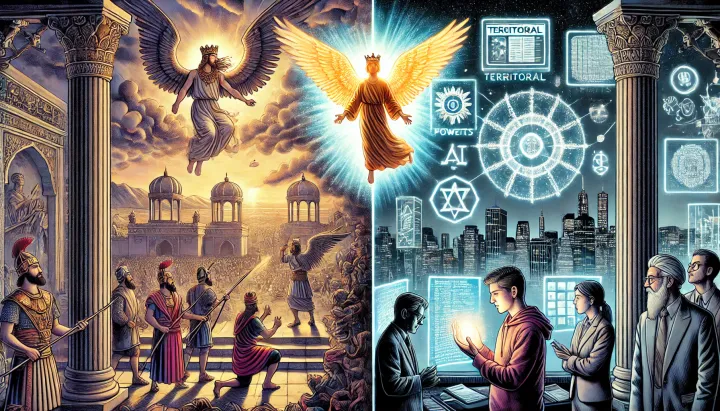Nathan Reynolds’ Story: Born into a Luciferian Bloodline
He explains how ritual abuse uses a God-given survival mechanism—dissociation—to create silence. The brain splits. One half controls language and memory, the other buries trauma
1. The Warning
Nathan’s trauma is real, raw, and dark. He makes it clear: this isn’t just a fascinating listen. It’s a call to repentance. A warning is given—don’t listen casually or around children. This is spiritual war testimony from the front lines.
2. Meet the Survivor: Nathan Reynolds
Nathan Reynolds author of Snatched from the Flames, a spiritual warfare “rookie,” and a permaculture farmer. But the most shocking truth is that he was born into a Luciferian bloodline—a family empire built on darkness, ritual, and control. He doesn't speak as a victim but as someone raised in the devil’s kingdom, now walking in resurrection.
3. The Luciferian Bloodlines Are Real
Nathan exposes what many Christians deny: that ancient bloodlines devoted to Lucifer still operate. These families believe they have divine right to rule because of their seed. They’ve archived rituals, texts, and power structures passed down for generations. To them, their identity isn’t metaphor—it’s inherited dominion. And their goal is not survival, but sovereignty over mankind through bloodline purity and allegiance to the Dragon.
4. The Covenant of Death
He details the chilling initiation he endured. This wasn’t just heritage—it was ritual. As a child, Nathan was brought into blood-oaths, drinking the blood of others, entering a parasitic covenant with the spirit of Death. These rituals promised freedom from the curse—ease in work, childbirth, and control over enemies—but the cost was allegiance to a fallen power. He wasn’t just traumatized—he was recruited.
5. The Cruelest Mockery of Christ
The had kids do awful things including crucifing a man dressed as Jesus. This was spiritual engineering: to reverse the gospel, to make Jesus the abuser and Death the savior.
6. Weaponized Dissociation and the Creation of Alters
Nathan describes how dissociation was used against him. Trauma split his mind into compartments—what modern science calls DID. One part of him lived a “normal” Christian life. The other was the ritualized child, trained in darkness. Families like his use trauma to split, then program, these alters. Strategic demonic implants and spiritual gatekeepers are installed in the soul. They call it science, but it’s sorcery.
7. A House Divided: Christian by Day, Cult by Night
Most confusing of all, his family lived double lives. His parents were “sincere Christians” in the day-life, attending church, raising hands, quoting Scripture. But they were also participants in ritual abuse on pagan feast days like Beltane. The alters that held the trauma were invisible to the church and even to parts of his conscious self. This split reality shows how evil hides in plain sight.
8. The Strategic Weakening of the Church
Nathan is painfully honest: the agents of darkness are more serious about their assignment than the average Christian. He sees most believers as institutionalized—fed watered-down, porridge gospels that train them to be weak. The true gospel—to destroy the works of the devil—is almost never preached. Yahweh is El Shaddai, Jesus is the warrior Messiah, but the church has forgotten their badge: “For this purpose the Son of God was manifested, to destroy the works of the devil.” — 1 John 3:8 (KJV)
9. The Encounter with the Real Jesus
Though not fully described in this clip, the trajectory turns here. Nathan hints that he eventually did meet the true Messiah—not the false Jesus of the rituals, but Yeshua, the warrior. This came after a process of deliverance, deprogramming, and facing the dissociated alters that held pain and secrets. Only the authority of the real Jesus had the power to enter those sealed places and reclaim them from darkness.
10. A Mandate for the Saints
Nathan’s message is a prophetic rebuke and a plea. To recognize the counterfeit, you must know the real. Christians must stop living on spiritual supplements. They must reclaim scripture for themselves, understand the ancient war of seedlines, and stand as warriors—not just churchgoers. His life was stolen, fragmented, and hijacked—but Jesus restored him. Now, he exposes the bloodline systems from within. Because this isn’t about escape—it’s about overthrow.
11. Two Men: One Father, One Enforcer
Nathan explains how even within his family system, two distinctly different men would appear—his father, and another man who functioned more as an enforcer, coming in when his mother began resisting her programming. This man’s role was to re-anchor her to the control systems. These people walked among the normal, unknowing public. You’d never suspect what they carried. But later, as Nathan’s deliverance process began, the veneer peeled back. What once looked like ordinary people began to reveal the demonic strongholds behind the mask. He began to discern not just evil acts, but evil presences in human hosts.
12. The Arena of Meekness: When Jesus Spoke Through a Strongman
Nathan recounts the exact moment the real Jesus broke through. It was a few months after his darkest ritual covenant. He was seven years old. Sitting in front of the TV, watching massive men bend steel and tear phone books, he saw something deeper. One of these men confessed that his strength was nothing—he said Jesus had greater power. It wasn’t a show. It was meekness. A warrior who laid down power to take up true authority. Nathan says this was the first time he saw a man truly yielded. And that’s when he believed. That’s when he wanted that kind of power—pure, flowing, not demonic or parasitic, but alive like a river. He surrendered.
13. The Battle of Two Hemispheres: Split Brain, Split Belief
Even after this encounter, his soul remained divided. One half of his brain associated Jesus with torture and betrayal—the false Christ who abused him. The other half remembered the river, the power, the deliverance. He admits this tension still lingers today. The trauma splinters belief. The left brain is filled with theological knowledge. The right brain holds locked pain. And the church has mostly taught from the left—words without power, as Paul warned in 2 Timothy 3:5: "Having the appearance of godliness, but denying its power."
14. The Ongoing Wrestling Match
Nathan doesn’t sugarcoat it. He still struggles. His healing is not complete. Not every part of him is persuaded that Jesus will bring justice now. He watches wicked people flourish, abusers praised, child traffickers protected. He’s seen justice teased, then denied, again and again. These unresolved horrors live as “burning briars” in the back of his mind. And yet, he confesses: he still believes the King will speak a word and set all things right. That faith doesn’t erase the pain—but it sustains him. He lives between groaning and glory.
15. Deliverance and Dissociation: How Trauma Hijacks Speech
He explains how ritual abuse uses a God-given survival mechanism—dissociation—to create silence. The brain splits. One half controls language and memory, the other buries trauma. That’s why victims don’t speak: they can’t. But the truth leaks out in other ways—paintings, songs, self-harm, nightmares. And if the body of Christ isn’t trained to recognize it, society will mislabel it as mental illness and drug it into submission. The church must be trauma-literate and equipped for deliverance—not afraid to name what evil actually looks like in modern form.
16. The Silence Around the Scales
Nathan references Paul’s conversion in Acts: when “scales” fell from Saul’s eyes. But where else in Scripture are “scales” mentioned? The serpent. “Now the serpent was more cunning than any beast of the field…” — Genesis 3:1. These are not metaphorical scales—they’re spiritual blinders put in place by the dragon to prevent people from seeing truth. Nathan asserts that these scales must be shattered by real, spoken, specific deliverance—not vague positivity or platitudes. Until that happens, people will remain unable to even hear the true gospel.
17. Pharmakeia and the Prophetic Muzzle
Nathan lays out how much of the modern response to trauma is spiritual sedation. Trauma survivors are often handed pills—“pharmakeia,” or sorcery, in biblical language (see Revelation 18:23)—which mute the symptoms but entomb the soul. Instead of freedom, they’re given a soft grave. But Scripture says "You shall know the truth, and the truth shall make you free." — John 8:32. That truth must be spoken—no matter how vile, humiliating, or unbelievable. That’s why Nathan speaks. He’s not trying to be shocking. He’s trying to unlock prison cells.
18. A Warrior Who Weeps
One thing that sets Nathan apart is his honesty. He doesn’t pretend he’s fully healed. He names the parts of himself still wounded, still waiting. The church often demands a “finished product” before listening. But Nathan stands as a paradox to the fake perfect Christian: a warrior in process, still bleeding, still believing. He’s unafraid to say, “I wrestle with doubt. I still want justice. I still hear from people being raped in real time, and I can’t call anyone who will do something.” That honesty is its own kind of intercession.
19. The False Fathers in Authority
In one of the most chilling revelations, Nathan mentions that the very people who stood in authority in his town—morticians, police chiefs, civic leaders—were part of the same Luciferian cult. You can’t call the police when the police are the cult. The system is not broken—it was built that way. Psalm 82:2-4 cries out: "How long will you judge unjustly and show partiality to the wicked? Give justice to the weak and the fatherless!" But instead of justice, these systems bury evidence, silence victims, and protect bloodlines. The Church must wake up: it is the last line of defense.
20. The Voice of the One Still Bleeding
Nathan’s story is not wrapped in a bow. It is not complete. But it’s sacred. Because he speaks while still healing. He prays while still trembling. He is the voice of every child too terrified to remember. He is Saul, mid-scales. He is David, crying in the cave. And he is also a John the Baptist in the wilderness, making straight the way of the Lord—not with soft words, but with truth that splits the air like a sword. That’s the real prophetic call: to expose, to name, and to invite others to the power that is stronger than anything hell ever offered—Jesus, the Lamb who was slain, and the Lion who returns.
Would you like a part 3 (episodes 21–30) with more of the key revelations from his journey—like how permaculture became part of his healing, or the precise rituals used to create alters? Or would you prefer a scripture-based forensic breakdown of the spiritual technology mentioned (like the covenant of death, pharmakeia, and dissociation)?


Comments ()